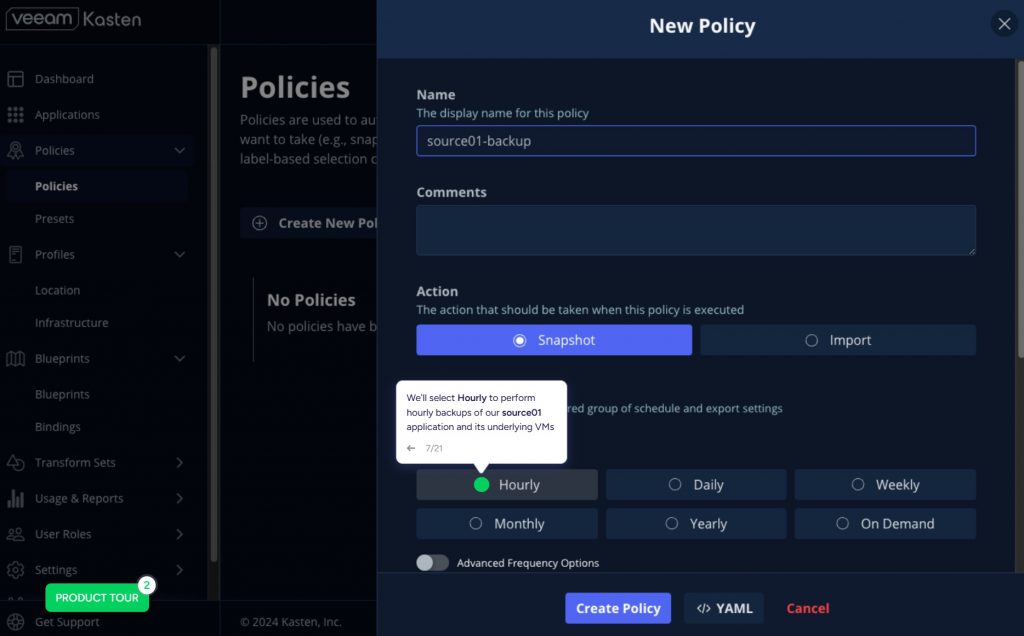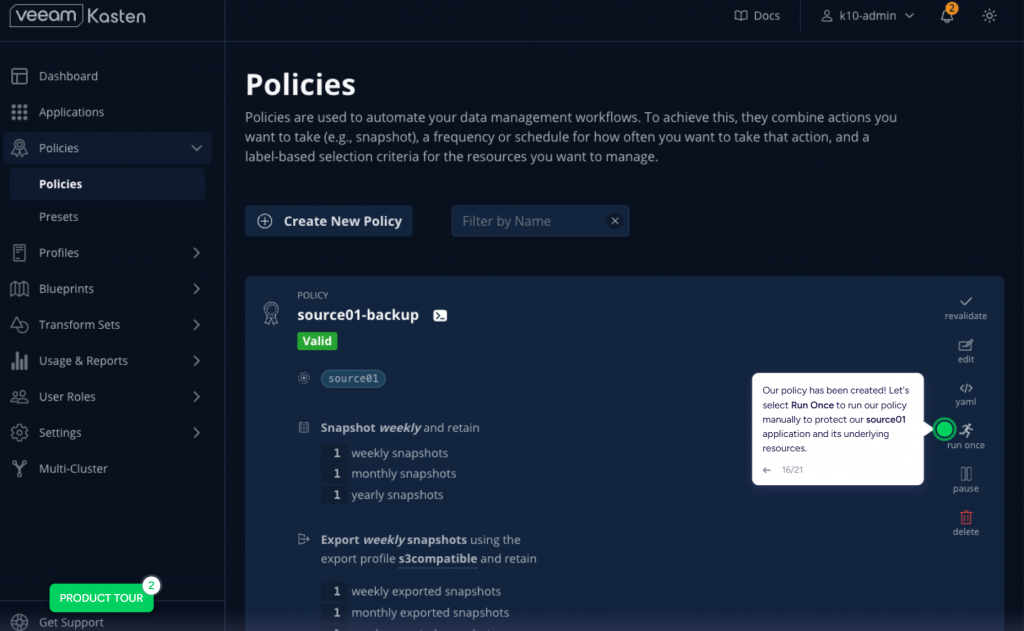Beyond Traditional VMs: Why Modern Virtualization with SUSE Rancher Prime and Veeam Kasten is Essential for Today’s Cloud-Native World
Co-authored by Jared Matkin | Sr. Manager, Alliances Product Marketing at Veeam Kasten
Introduction
In the rapidly evolving IT landscape, organizations face mounting pressure to modernize infrastructure while maintaining reliability and compliance. Traditional virtual machines (VMs) remain critical for many legacy workloads, but they often lack the flexibility, portability, and automation required by modern, cloud-native applications.
This is where modern virtualization, powered by SUSE Rancher Prime, SUSE Virtualization (formerly Harvester), and Veeam Kasten for Kubernetes, presents a transformative approach—blending the best of both virtual and containerized environments into a unified, secure, and automated platform.

Visual comparison of traditional VM stack vs. Kubernetes-native virtualization + containerization on SUSE Rancher Prime & SUSE Virtualization.
The Limitations of Traditional VM Infrastructure
Enterprises still heavily rely on VM-based workloads, but this legacy approach comes with challenges:
- High licensing and support costs from legacy hypervisor vendors
- Operational silos between VM and container stacks
- Limited portability and mobility of VM workloads
- Vendor fragility and lock-in
- Complex, fragmented backup and DR strategies
These issues make scaling and innovating with legacy platforms both costly and risky.
SUSE Virtualization + SUSE Rancher Prime: A Unified Platform
SUSE Virtualization breaks the barrier between VMs and containers by enabling VM workloads to run directly on Kubernetes-native infrastructure. This is tightly integrated with SUSE Rancher Prime, providing centralized orchestration, automation, and observability across all workloads.
With this architecture, organizations can:
- Run VMs and containers side-by-side on the same clusters
- Use SUSE Rancher Prime to manage infrastructure from a single control plane
- Enable GitOps, policy-as-code, and CI/CD workflows across environments

How SUSE Virtualization integrates both container and VM lifecycle management.
Solving the Backup Gap: Why Veeam Kasten is Critical
While SUSE Virtualization includes native snapshot and backup functionality, production-grade environments demand more robust, secure, and scalable backup solutions.
Veeam Kasten delivers exactly that. It extends Kubernetes-native backup and recovery capabilities to VMs running inside SUSE Virtualization, offering:
- Immutable backups on S3-compatible and secure external storage
- Ransomware protection through air-gapped, tamper-proof backups
- Granular, application-aware recovery for both VMs and containers
- Cross-cluster disaster recovery, enabling restore to any Kubernetes environment
- Storage agnostic support, including NFS, cloud buckets, and hybrid environments

Diagram showing backup and restore flows between SUSE Virtualization VMs, Kubernetes clusters, and storage backends.
From Manual to Automated
SUSE Virtualization provides basic snapshot and backup capabilities for virtual machines, which are useful for quick, local restores. However, for enterprise-grade environments that demand consistency, scale, automation, and long-term data protection, Veeam Kasten adds essential functionality on top of SUSE Virtualization’s snapshot system.
What SUSE Virtualization provides
- Manual or scheduled VM snapshots
- Local backup and restore of VM volumes
- Snapshot-based rollback
What Veeam Kasten adds
- Automated, Policy-Driven Protection
Veeam Kasten allows backup and restore policies to be defined as code (CRDs in Kubernetes), turning SUSE Virtualization’s manual process into a fully automated, repeatable, and auditable workflow. - Multi-Tier, Multi-Location Storage Targets
Veeam Kasten supports snapshot export to cloud storage (e.g., AWS S3, Azure Blob), NFS, or on-prem object stores — enabling long-term retention and offsite disaster recovery beyond SUSE Virtualization’s local scope. - App-Aware and Granular Recovery
Using application blueprints, Kasten ensures crash-consistent or application-consistent backups, even for stateful services inside VMs (e.g., databases), which SUSE Virtualization snapshots alone cannot guarantee. - Cross-Cluster Portability and Restore
Veeam Kasten lets users restore VM workloads to different clusters or environments, unlocking hybrid cloud mobility not natively supported by SUSE Virtualization alone. - Centralized Management with SUSE Rancher
Quickly access the Veeam Kasten UI from SUSE Rancher Prime, and manage all Kasten backup policies and schedules.
Policy-Driven Automation at Scale
Veeam Kasten stands out with its declarative, policy-driven automation for backup and disaster recovery. Built to scale with Kubernetes, it allows teams to:
- Define automated backup schedules and retention rules via CRDs
- Group workloads by namespace, label, or application
- Apply tiered storage strategies for cost optimization
- Manage policies across multi-cluster environments
- Enable GitOps integration for version-controlled, auditable backup configurations
This approach aligns backup management with modern DevOps workflows — eliminating manual errors, ensuring consistency, and simplifying audits.
With the Veeam Kasten UI, creating a policy is easy:
Screenshot below shows how to create backup policy, which can be executed as per backup frequency

Screenshot below shows the facility to take backup as per the convenient slot, also can perform backup at identified not peak hours.

Screenshot below shows the facility to take backups based on Namespace labels, names. Also can change backup targets to available NFS and S3 compatible storage providers.

Once a policy is created, it will automatically perform a backup as per the configurations.

Screenshot below shows the facility to execute backup policy manually whenever required.

Sheenshot below shows the simple restore option available if you want to rollback on a particular restorepoint

Screenshot below shows the restoring backup is very straightforward, needs to choose the restore point, and it will automatically bring the application back to the past state.

See for yourself how easy it is to use Veeam Kasten to create backup policies with the interactive tour
Security and Compliance You Can Trust
This joint SUSE and Veeam solution is built with enterprise-grade security and compliance in mind. Organizations benefit from:
- Zero-trust architecture with isolated, role-based access control
- Audit-ready logs and reports for compliance standards
- Reliable recovery SLAs for mission-critical applications
It is a secure, transparent solution that meets the needs of highly regulated industries without compromising agility.
The Business Case: Efficiency and Future-Readiness
This modern virtualization stack offers significant advantages over traditional VM infrastructure:
Challenges of Traditional VMs
- Rising costs from hypervisor and backup software licensing
- Siloed backup workflows for VMs versus containers
- Manual DR testing and inconsistent protection
- Increased ransomware exposure with limited immutability
- Lack of cloud mobility or cross-cluster disaster recovery
Benefits of SUSE Virtualization and Veeam Kasten
By migrating VM workloads to SUSE Virtualization and implementing Veeam Kasten, Organizations can achieves:
Enhanced Data Security
- Immutable, ransomware-proof backups stored in secure object storage
- App-aware backups for VMs with application-consistent recovery
- End-to-end encryption and RBAC, aligned with security policy and compliance needs
- Multi-site DR readiness across clusters, datacenters, and clouds
Measurable Cost Savings
- Eliminates proprietary hypervisor licensing costs by moving to open-source SUSE Virtualization
- Unified data protection reduces the need for multiple backup tools
- Automated, policy-driven operations lowered administrative overhead
- Optimizes storage usage by leveraging tiered backup targets (e.g., low-cost cloud buckets)
Seamless Operations
- Centralizes management of VM and container backups in SUSE Rancher Prime
- GitOps-based policies enables DevOps to maintain protection-as-code
- Simplifies audit and compliance reporting with unified dashboards
Modern infrastructure isn’t about choosing between VMs or containers—it’s about enabling both to thrive together in a secure, automated, and scalable way. SUSE Rancher Prime, SUSE Virtualization, and Veeam Kasten bring together the tools IT leaders need to confidently run mixed environments, protect critical data, reduce risk, and accelerate cloud-native adoption.
To learn more email us at isv-cosell@suse.com.
Related Articles
Nov 14th, 2023
Top 3 Reasons to find SUSE at AWS re:Invent
Oct 15th, 2024
What’s new in SUSE Edge 3.1?
Mar 13th, 2024